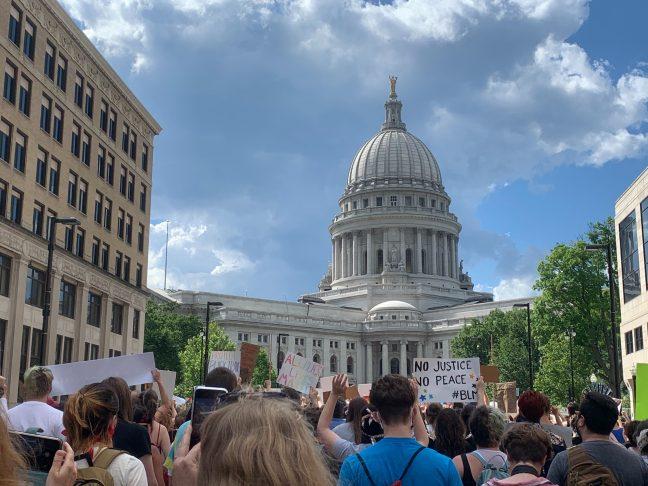In late August, during the several days of protests and civil unrest in the wake of the shooting of Jacob Blake by a Kenosha police officer, The Kenosha News published an article and video with the now-removed headline “Kenosha speaker: If you kill one of us, it’s time for us to kill one of yours.”
Not long after, the sole Black journalist on staff, Daniel Thompson, resigned from his position as digital editor in response to the incendiary headline that, in Thompson’s words, “did not reflect the messages of Blake’s family and other speakers at an event that featured remarks, songs and a peaceful march.”
In the past, such a resignation might have gained minimal news coverage, but what is significant about The Kenosha News’ misrepresentation is that similar situations are happening in newsrooms across the U.S., with Black newsroom staff feeling fed up with ignorant op-eds, headlines and racially homogenous staffing.
For example, after the Philadelphia Inquirer published an article decrying damage caused by looters with the headline, “Buildings Matter, Too,” now-former Executive Editor Stan Wischnowski stepped down, but not before several Black staff members condemned the headline and called in sick to work.
Debate surrounding Lincoln statue will have generational effect
During the height of the protests that ensued after a Minneapolis police officer killed George Floyd, Sen. Tom Cotton, R-Arkansas, wrote an op-ed for the New York Times entitled, “Send in the Troops,” which was swiftly met with fierce criticism by NYT staff and readers, ultimately forcing James Bennet, the now-former NYT opinion editor, to resign.
While Cotton’s calls for an “overwhelming show of force to disperse, detain and ultimately deter lawbreakers” to subdue looters and “restore order” pose a far different threat than a poorly selected headline, Cotton filled his piece with unsubstantiated claims which inherently threaten objective journalism, not to mention the potential for impressionable readers to turn to violent tactics in agreement.
Considering the persistent lack of diversity in newsrooms nationwide, it’s not particularly surprising to see insensitive or ill-advised headlines and pieces featured on front pages.
According to a study on newsroom diversity from the Pew Research Center, about 77% of newsroom staff are white and 61% are male, with those above 50 being “disproportionately male.” This indicates that while a younger generation of journalists might be more diverse than their older colleagues, there is still a glaring lack of representation in a field that should be the most representative of U.S. demographics.
Given how little progress has been made to improve such disparities, many newspapers are now pledging to hire reporters who more accurately represent the communities they serve. For instance, the Milwaukee Journal Sentinel plans to double the number of Black journalists on staff, as well as hire more Latino and women reporters, all of whom are disproportionately underrepresented in the newsroom in comparison to the greater Milwaukee community.
Tale of Two Candidates: How Harris, Pence’s visits to Wisconsin reflect campaign efficacy
The homogeneity apparent within the field of journalism doesn’t simply alienate the few reporters of color, but also does a disservice to readers who ultimately feel unheard by news outlets, whether it’s for lack of attention to racial tensions, or not enough local coverage in minority-populated communities.
In a 2014 study by the American Press Institute and the Associated Press-NORC Center for Public Affairs Research, just 25% of African American respondents and 33% of Hispanic respondents reported feeling accurately portrayed by news media.
According to Buzzfeed Editor in Chief Ben Smith, newsroom diversity “‘helps editorial organizations avoid the bland and often false conventional wisdom held in a room full of people who come from similar places.’” Racial and gender uniformity among staff may not allow for a broad range of stories, given that journalists tend to hone in on topics relevant and personal to them, rather than other marginalized communities.
“‘Unless you are exposed to [racial issues] all of the time, you don’t have that awareness, and therefore it makes it much harder to compel yourself to act,” The Atlanta Journal-Constitution editor Kevin Riley said.
But, while representation is essential in reporting stories that may go overlooked by majorly white newsrooms, racial diversity may not inherently equate to ideological diversity, especially considering the large population of journalists that come from the same batch of elite schools.
Closer look at Green Party’s attempt to enter Wisconsin ballot
A wide-ranging array of ideological backgrounds, in addition to a racially diverse staff, is at the crux of objective reporting. Bias is implicit in everything people do, which is why it is imperative that those who explain the rest of the world to us every day represent a multitude of backgrounds to prevent from spewing the same biases repeatedly.
Facts are indisputable, but what reporters choose to report on and the ideas we choose to promote vary based on our personal experiences. To maintain true objectivity, we need more than a singular voice to ensure fair reporting.
Anne Isman ([email protected]) is a sophomore studying economics.














